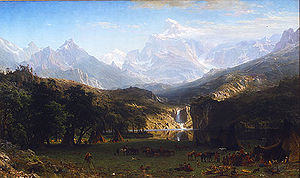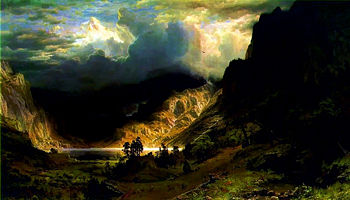Albert Bierstadt
| Albert Bierstadt | |
 "Albert Bierstadt" by Napoleon Sarony | |
| Born | January 07 1830 Solingen, Germany |
| Died | February 18 1902 (aged 72) |
| Nationality | German-American |
| Field | painting |
| Training | Düsseldorf School |
| Movement | Hudson River School |
| Famous works | |
| Influenced | William Bliss Baker |
Albert Bierstadt (January 7 1830 - February 18 1902) was a German-American painter best known for his large landscapes of the American West. In obtaining the subject matter for these works, Bierstadt joined several journeys of the Westward Expansion. Though not the first artist to record these sites, Bierstadt was the foremost painter of these scenes for the remainder of the 19th century.
Bierstadt was part of the Hudson River School, not an institution but rather an informal group of like-minded painters. The Hudson River School style involved carefully detailed paintings with romantic, almost glowing lighting, sometimes called luminism.
Early Life
Bierstadt was born in Solingen, Germany. His family moved to New Bedford, Massachusetts, in 1833. He studied painting with the members of the Düsseldorf School in Düsseldorf, Germany from 1853 to 1857. He taught drawing and painting briefly before devoting himself to painting.
Career
Bierstadt began making paintings in New England and upstate New York. In 1859, he traveled westward in the company of a Land Surveyor for the U.S. government, returning with sketches that would result in numerous finished paintings. In 1863 he returned West again, in the company of the author Fitz Hugh Ludlow, whose wife he would later marry. He continued to visit the American West throughout his career.
Though his paintings sold for princely sums, Bierstadt was not held in particularly high esteem by critics of his day. His use of uncommonly large canvases was thought to be an egotistical indulgence, as his paintings would invariably dwarf those of his contemporaries when they were displayed together. The romanticism evident in his choices of subject[1] and in his use of light was felt to be excessive by contemporary critics, a charge that continues to be leveled by many of today's art historians. His paintings emphasized atmospheric elements like fog, clouds and mist to accentuate and complement the feel of his work. Bierstadt sometimes changed details of the landscape to inspire awe. The colors he used are also not always true. He painted what he believed is the way things should be: water is ultramarine, vegetation is lush and green, etc. The shift from foreground to background was very dramatic and there was almost no middle distance.[citation needed]
Nonetheless, his paintings remain popular. He was a prolific artist, having completed over 500 [2] (possibly as many as 4000) paintings during his lifetime, most of which have survived. Many are scattered through museums around the United States. Prints are available commercially for many. Original paintings themselves do occasionally come up for sale, at ever increasing prices.
Existing Work
- Oregon Trail, 1869 at the Butler Institute of American Art
- Puget Sound on the Pacific Coast, 1870 at the Seattle Art Museum
- The Wolf River, Kansas at the Detroit Institute of Arts
- several pieces at the Museum of Fine Arts, Boston
- Alaskan Coast Range, ca. 1889 at the Smithsonian American Art Museum
- Among the Sierra Nevada, California, 1868 at the Smithsonian American Art Museum
- Domes of Yosemite ca. 1871 at the St. Johnsbury Athenaeum, St. Johnsbury, Vermont
- Cathedral Rocks, Yosemite Valley, ca. 1872 at the Smithsonian American Art Museum
- Gates of the Yosemite, ca. 1882 at the Smithsonian American Art Museum
- Indians in Council, California, ca. 1872 at the Smithsonian American Art Museum
- San Francisco Bay, 1871-1873 at the Smithsonian American Art Museum
- Sunrise in the Sierras, ca. 1872 at the Smithsonian American Art Museum
- Sierra Nevada Morning at the Gilcrease Museum
Legacy
Because of Bierstadt's interest in mountain landscapes, Mount Bierstadt in Colorado is named in his honor. Another Colorado mountain was originally named Mount Rosa, after Bierstadt's wife, but it was later renamed Mount Evans after Colorado governor John Evans.
In 1998, the United States Postal Service issued a set of 20 commemorative stamps entitled "Four Centuries of American Art," one of which featured Albert Bierstadt's The Last of the Buffalo. [1]
William Bliss Baker, another landscape artist, studied under Bierstadt.
See also
- History of painting
- Western painting
- Edward Bierstadt
Notes
ReferencesISBN links support NWE through referral fees
- Anderson, Nancy K. et. at. Albert Bierstadt, Art & Enterprise, Hudson Hills Press, Inc.: New York, New York, 1990.
- Hendricks, Gordon. Albert Bierstadt, Painter of the American West, Harrison House/Harry N. Abrams, Inc.: New York, New York 1988.
External links
- White Mountain paintings by Albert Bierstadt. Retrieved May 3, 2008.
- Albert Bierstadt Biography and Images: Hollis Taggart Galleries. Retrieved May 3, 2008.
- Gallery of Bierstadt's Paintings. Retrieved May 3, 2008.
- The Winterthur Library Overview of an archival collection on Albert Bierstadt. Retrieved May 3, 2008.
| ||||||||||||||
Credits
New World Encyclopedia writers and editors rewrote and completed the Wikipedia article in accordance with New World Encyclopedia standards. This article abides by terms of the Creative Commons CC-by-sa 3.0 License (CC-by-sa), which may be used and disseminated with proper attribution. Credit is due under the terms of this license that can reference both the New World Encyclopedia contributors and the selfless volunteer contributors of the Wikimedia Foundation. To cite this article click here for a list of acceptable citing formats.The history of earlier contributions by wikipedians is accessible to researchers here:
The history of this article since it was imported to New World Encyclopedia:
Note: Some restrictions may apply to use of individual images which are separately licensed.


